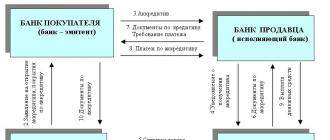When concluding new transactions between individuals and individual entrepreneurs, organizations and enterprises, the question often arises: "How to insure against the dishonesty of counterparties and avoid losing money or goods?" This issue is especially relevant when payment for goods is made in advance. At the same time, the risks increase if a contract is concluded for a significant amount with foreign partners. The solution is simple - to use letters of credit in the calculations. Not everyone knows what a letter of credit is. However, having studied all the subtleties of this type of settlement, clients feel more secure and confident in carrying out large transactions.
Letter of credit: what is it in plain language?
A letter of credit is a form of non-cash settlement, which is carried out under the control of two banking organizations. The bank, which protects the interests of the buyer, transfers money to the account of the seller of the product (service) only if the seller submits the necessary documents to the bank. The list of documents is drawn up at the conclusion of the transaction and is prescribed in the contract.
The scheme of interaction between partners may become a little more complicated, it all depends on the type of letter of credit. Despite this, the banking organization acts as an intermediary, which ensures the execution of the transaction for a certain fee.
Benefits of a letter of credit for the buyer
 Calculations under a letter of credit, in comparison with other forms of payment, have advantages for the buyer:
Calculations under a letter of credit, in comparison with other forms of payment, have advantages for the buyer:
- money is transferred to the seller only after the delivery of the goods to the buyer - for this it is necessary to provide the bank with the entire necessary list of documents drawn up properly;
- if delivery is not made, the money is returned to the buyer within a predetermined time frame;
- the bank guarantees that the goods will be delivered in the agreed volume and range, as well as of proper quality, since the seller is obliged to provide the bank employees with documents confirming the range, quality and quantity of goods;
- the risk of negative tax consequences of the transaction is reduced - the bank guarantees the correct execution of the documents accompanying the transaction, otherwise the bank will not transfer the money to the seller's account;
- settlements under a letter of credit can be provided by the bank on credit on favorable terms for the buyer - this allows not to withdraw a large amount of funds from circulation to pay for the transaction.
Scheme of using a letter of credit
 We have found out what a letter of credit is. Now let's figure out how, in practice, transactions are carried out with this form of payment.
We have found out what a letter of credit is. Now let's figure out how, in practice, transactions are carried out with this form of payment.
Stage 1. The seller and the buyer sign a contract (agreement of purchase / sale, delivery of goods, provision of services), in the conditions of which the form of settlements under the letter of credit is prescribed, as well as the conditions for its disclosure.
Stage 2. The buyer submits an application to the bank and a copy of the contract. On the basis of the documents provided, the banking organization opens a letter of credit. If necessary, the letter of credit can be confirmed by the seller's bank, if these requirements are provided for by the contract.
Stage 3. The coverage of the letter of credit is formed either at the expense of the customer-buyer, or on the basis of a loan provided to this person by the issuing bank.
Stage 4. The seller delivers the goods, sends duly executed documents to the bank. After the bank checks the fulfillment of all conditions, a letter of credit is opened, and the seller receives payment.
Stage 5. The buyer receives the goods and all accompanying documents.
This scheme is simple and transparent. The issued letter of credit acts as a guarantee of payment for the supplier, and for the buyer it reduces the risk of losing money, as in the case of an advance payment to an unknown counterparty. At the same time, the bank accompanies the transaction, checking its purity.
Types of letters of credit
 The resolutions of the Central Bank of the Russian Federation stipulate the possibility of opening the following types of letters of credit:
The resolutions of the Central Bank of the Russian Federation stipulate the possibility of opening the following types of letters of credit:
- Covered (deposited) bank letter of credit - what it is, in simple terms, you can describe it as follows: the buyer opens an account with the bank and transfers to it funds in the amount necessary to cover the letter of credit. The issuing bank transfers the amount to the correspondent account of the financial institution where the seller's account is opened. This is the most common type of settlement for letters of credit.
- Uncovered (guaranteed) letter of credit - the issuing bank does not transfer funds to the executing bank, but provides the opportunity to write off funds from the account opened with it, within the amount specified in the contract. The procedure and terms for debiting funds from the account of the issuing bank occurs in accordance with the existing interbank agreement.
- Revocable - a documentary letter of credit that can be revoked, changed or canceled by the bank on behalf of the payer without the consent of the supplier and even without prior notice.
- Irrevocable is a type of agreement that can be canceled only after the executing bank receives consent to change the conditions from the supplier of the goods. There is no partial acceptance of the terms of an irrevocable letter of credit.
- Confirmed is a form of interaction that implies an additional guarantee of payment from a bank that is not an issuer. The financial institution undertakes to pay for the goods (services), even if the issuing bank refuses to make the payment. This form of interaction applies only to an irrevocable letter of credit. An additional payment of a commission to the bank is required for confirmation.
Additional varieties
 Today there are several other types of letters of credit. They are varieties of those described above.
Today there are several other types of letters of credit. They are varieties of those described above.
A documentary credit with a red clause is an agreement according to which the executing bank receives the authority from the issuing bank to make an advance payment to the supplier of the goods in the amount specified in the contract until the moment when the goods are fully delivered or the service is fully provided.
Revolving view - opens when the contract provides for several deliveries of approximately equal cost in parts over a certain period of time. The letter of credit is opened for an amount equal to one delivery, with the condition that after each payment, the original amount will be restored to the account. In parallel with this, the contract amount will decrease cyclically.
Transferable (transferable) letter of credit - makes payments not only in favor of the seller, but also in favor of third parties (suppliers). This type is used when the seller delivers through the supplier and is not a direct consignor. The third party, having shipped the goods to the specified address, provides the necessary documents to the executive bank, after which all previously agreed payments are made in his favor.
How to choose the type of letter of credit?
 As a rule, participants must independently determine the form of the letter of credit and coordinate it with the bank. The main factors influencing the choice of a letter of credit are the terms of the transaction and the interests of the parties. To do this, you need to understand exactly what a letter of credit is and which of its forms are used in our country.
As a rule, participants must independently determine the form of the letter of credit and coordinate it with the bank. The main factors influencing the choice of a letter of credit are the terms of the transaction and the interests of the parties. To do this, you need to understand exactly what a letter of credit is and which of its forms are used in our country.
At the moment, Russian legislation on the settlement of non-cash payments is somewhat behind our western neighbors, so you can focus on the international rules for documentary letters of credit developed by the International Chamber of Commerce.
It should be borne in mind that not every bank is ready to agree to non-standard terms of the letter of credit. This is due, to a greater extent, to the lack of qualified specialists in this area. Therefore, before including non-standard terms in the main agreement, you need to agree on them with the banks of the recipient and the payer of funds.
Settlement participants
In order to choose this form of payment, it is not enough to know what a letter of credit is. You must also understand that, like any other form of cashless payments, it has its drawbacks.
This transaction involves not two parties, as in ordinary settlements, but four. In addition to the seller and the buyer, the seller's bank and the buyer's bank participate here, where a simple letter of credit is opened, an account and all the main operations take place. This introduces certain difficulties in the transaction.
Complexities of registration
 Settlement under a letter of credit implies strict requirements for documents and deadlines, as well as the complication of the registration procedure. In addition to drawing up the main contract between the buyer and the seller, it is required to exchange documents between banks. Despite the fact that this is now done electronically, it takes time to check all documents.
Settlement under a letter of credit implies strict requirements for documents and deadlines, as well as the complication of the registration procedure. In addition to drawing up the main contract between the buyer and the seller, it is required to exchange documents between banks. Despite the fact that this is now done electronically, it takes time to check all documents.
Expensive service
The cost of this type of payment is quite high. The bank charges a commission for all transactions carried out with letters of credit. In addition, from the moment the letter of credit is opened, the money in the buyer's account is frozen, which is a guarantee of the coverage of the letter of credit.
Conclusion
Despite all its shortcomings, this form of payment is reliable and convenient for all parties to the transaction. Having understood all the intricacies of the process, the client will no longer be able to refuse this type of settlement.






